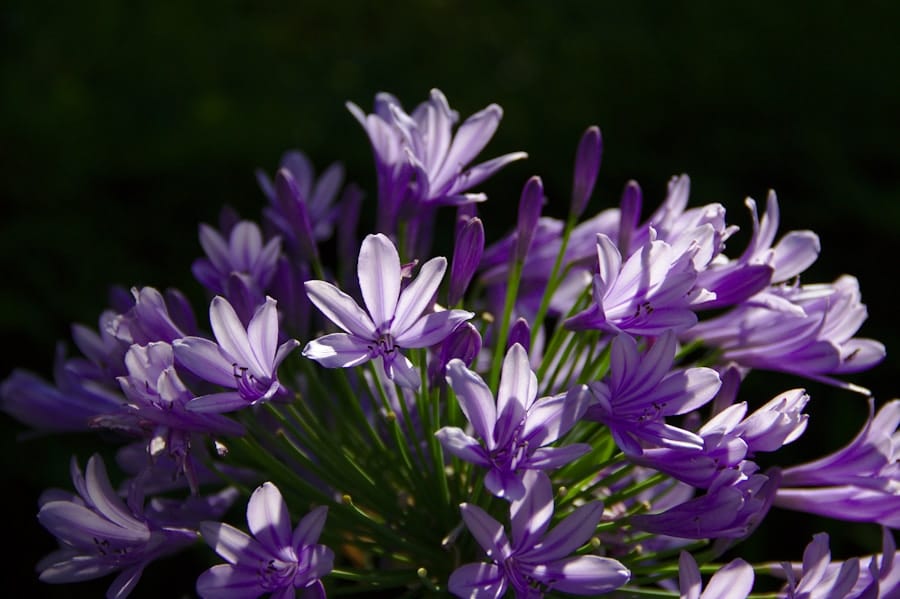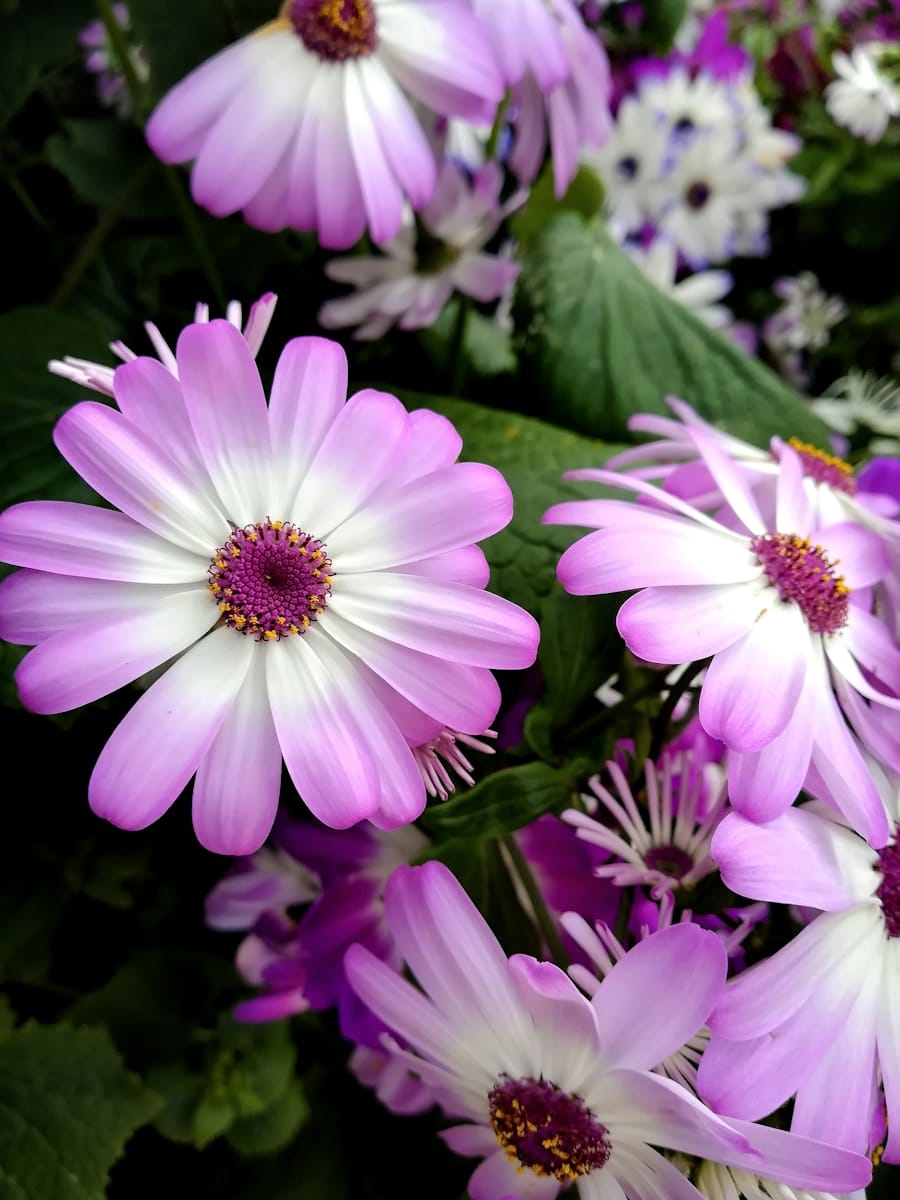As I stroll through gardens and parks, I often find myself captivated by the enchanting beauty of purple and white flowers. These colors, when combined, create a striking visual contrast that can evoke a sense of tranquility and elegance. The deep, rich hues of purple, reminiscent of twilight skies, paired with the pure, pristine whites, evoke feelings of serenity and peace.
Together, they form a harmonious palette that can transform any space into a serene oasis. The allure of purple and white flowers lies not only in their aesthetic appeal but also in their ability to convey emotions and set moods. Whether it’s the soft lavender of a blooming lilac or the bold violet of an iris, these flowers have a unique way of drawing the eye and inviting contemplation.
White flowers, on the other hand, symbolize purity and innocence, often serving as a backdrop that enhances the vibrancy of their purple counterparts. This combination can create a stunning focal point in any garden or floral arrangement, making it a favorite choice for many gardeners and floral designers alike. Visit Our Site for all your gardening needs.
Key Takeaways
- Purple and white flowers create a stunning and elegant combination in any garden or floral arrangement.
- Popular varieties of purple and white flowers include lavender, lilac, hydrangea, and orchids.
- Incorporate purple and white flowers in your garden by planting them in clusters or using them as borders for a striking visual impact.
- Purple and white flowers symbolize purity, elegance, and grace, making them perfect for weddings and special occasions.
- To care for purple and white flowers, ensure they receive adequate sunlight, water, and proper soil drainage. In floral arrangements, use purple and white flowers as focal points and complement them with greenery for a balanced look.
Popular Varieties of Purple and White Flowers
Lavender: A Soothing and Delicate Option
Some of my favorites include the elegant lavender, with its soothing fragrance and delicate spikes of purple blooms. Lavender not only adds beauty to my garden but also attracts pollinators like bees and butterflies, enhancing the overall ecosystem.
Iris and Daisies: A Striking Contrast
Another stunning option is the classic iris, which boasts striking purple petals that can range from deep indigo to soft lilac. Their unique shape and vibrant colors make them a standout choice for any garden. In addition to these, I find myself drawn to the charming white daisies that provide a cheerful contrast to their purple companions.
White Peony: Elegance and Lush Blooms
Their simple yet captivating appearance brings a sense of joy and lightness to my garden. Another delightful option is the white peony, which exudes elegance with its lush, full blooms. The combination of these flowers creates a beautiful tapestry of color and texture that can elevate any outdoor space. Each variety has its own unique characteristics, allowing me to create a diverse and visually appealing garden.
How to Incorporate Purple and White Flowers in Your Garden

Incorporating purple and white flowers into my garden design is an exciting endeavor that allows me to express my creativity. One approach I often take is to create themed flower beds that highlight these colors. For instance, I might dedicate a section of my garden solely to purple and white blooms, arranging them in clusters for maximum impact.
This not only creates a stunning visual display but also allows me to experiment with different heights and textures, adding depth to the landscape. Another technique I enjoy is mixing purple and white flowers with other complementary colors. For example, pairing them with soft yellows or vibrant greens can create a dynamic contrast that enhances the overall aesthetic.
I often use white flowers as a base to anchor the design while allowing the purple varieties to take center stage. Additionally, I find that incorporating various foliage types can add an extra layer of interest, making the garden feel lush and inviting.
The Symbolism of Purple and White Flowers
| Flower Type | Symbolism |
|---|---|
| Purple Roses | Symbolize enchantment and love at first sight |
| White Lilies | Represent purity, virtue, and the return of happiness |
| Purple Hyacinth | Signifies sorrow, forgiveness, and regret |
| White Orchids | Symbolize elegance, beauty, and innocence |
The symbolism behind purple and white flowers adds another layer of meaning to my gardening experience. Purple flowers are often associated with royalty, luxury, and ambition.
This rich color has historically been linked to nobility and power, making it a perfect choice for those looking to convey strength and dignity in their gardens.
When I see purple blooms flourishing in my garden, I am reminded of their regal heritage and the sense of pride they bring. On the other hand, white flowers symbolize purity, innocence, and new beginnings. They are often used in weddings and other significant life events to represent fresh starts and heartfelt emotions.
The combination of purple and white flowers can create a powerful statement, blending strength with purity. This duality resonates deeply with me as I cultivate my garden, reminding me that beauty can be both bold and gentle at the same time.
Tips for Caring for Purple and White Flowers
Caring for purple and white flowers requires attention to detail and an understanding of their specific needs. One essential tip I’ve learned is to ensure that these plants receive adequate sunlight. Most purple and white flowers thrive in full sun or partial shade, so I make it a point to observe how much light different areas of my garden receive throughout the day.
This knowledge helps me position my plants for optimal growth. Additionally, proper watering is crucial for maintaining healthy blooms. I’ve found that overwatering can be just as detrimental as underwatering, so I pay close attention to the soil moisture levels.
A good rule of thumb is to water deeply but infrequently, allowing the soil to dry out slightly between waterings. This encourages strong root development and helps prevent diseases that can arise from overly wet conditions. Regularly checking for pests and diseases is also part of my routine care; early detection allows me to address any issues before they escalate.
Using Purple and White Flowers in Floral Arrangements
When it comes to floral arrangements, purple and white flowers offer endless possibilities for creativity. I love experimenting with different combinations to create stunning bouquets that reflect my personal style. One approach I often take is to use purple flowers as the focal point while incorporating white blooms as accents.
This creates a beautiful balance that draws the eye without overwhelming the arrangement. In addition to traditional bouquets, I enjoy using purple and white flowers in centerpieces for special occasions. Whether it’s a dinner party or a wedding celebration, these colors can evoke a sense of elegance and sophistication.
I often mix various textures by adding greenery or other complementary flowers to enhance the overall look. The versatility of purple and white flowers allows me to create arrangements that suit any occasion, making them a staple in my floral design repertoire. In conclusion, the beauty of purple and white flowers is undeniable, offering both aesthetic appeal and rich symbolism.
From popular varieties to practical care tips, these blooms have become an integral part of my gardening journey. By incorporating them thoughtfully into my garden and floral arrangements, I am able to create spaces that are not only visually stunning but also filled with meaning and emotion. Whether I’m tending to my garden or crafting arrangements for special occasions, the allure of purple and white flowers continues to inspire me every day.
If you are a fan of purple and white flowers, you may be interested in learning more about how to start harvesting spices at home. Check out this article on when and how to start harvesting spices at home for some helpful tips on growing and harvesting your own herbs and spices.
FAQs
What are some examples of purple and white flowers?
Some examples of purple and white flowers include lavender, lilac, iris, petunia, and verbena.
What do purple and white flowers symbolize?
Purple flowers are often associated with royalty, luxury, and elegance, while white flowers symbolize purity, innocence, and spirituality. When combined, purple and white flowers can represent a sense of balance and harmony.
How do I care for purple and white flowers?
To care for purple and white flowers, it is important to provide them with the appropriate amount of sunlight, water, and nutrients. Each type of flower may have specific care requirements, so it is best to research the specific needs of the flowers you have.
Can I grow purple and white flowers in my garden?
Yes, many purple and white flowers can be grown in a garden, depending on the climate and growing conditions. It is important to choose flowers that are suitable for your specific location and to provide them with the proper care and maintenance.
Are there any specific meanings associated with different types of purple and white flowers?
Yes, different types of purple and white flowers may have specific meanings or symbolism. For example, lavender is often associated with calmness and relaxation, while white lilies are often used in funerals to symbolize purity and rebirth.


